Bringing a Golden Retriever into your life is an incredibly rewarding experience, full of playful energy and unwavering loyalty. As a new owner, you embark on a journey to create a strong and loving bond with your furry friend. A vital part of this journey is training. Early and consistent training is not just about teaching commands. The most important thing is to communicate clearly, build trust, and mold your Golden Retriever into a successful, well-behaved, and happy member of your family. This Golden Retriever Training Guide is designed to give you the basic knowledge and practical tips you need to start grooming your Golden Retriever the right way. We’ll cover important commands, effective training methods, and solve common problems. Learn how to mold your Golden Retriever into a confident, obedient, and happy companion. Let’s build a great relationship through positive and effective training!
Contents
- 1 Decode Your Golden Companion – Understand Their Behavior and Temperament for Successful Training
- 2 Golden Retriever Training Guide for Beginner’s
- 3 Golden Rules: The Basic Principles of Training Every Golden Retriever Owner Should Know
- 4 Basics: The First Basic Commands Every Golden Retriever Should Know
- 5 Paws in the Right Place: How to Potty and Crate Train a Golden Retriever
- 6 Happy Walks: Learn How to Use a Leash for Calm Walks with Your Golden Retriever
- 7 Change Your Approach: Puppy and Adult Dog Training Methods for Golden Retrievers
- 8 Troubleshooting Training: Overcoming Common Problems with Your Golden Retriever
- 9 Set Up for Success: Training Tools to Help Your Golden Retriever Learn
- 10 Make Time for Exercise: Create a Regular Routine for Your Golden Retriever
- 11 Golden Path to the Future: Latest Tips and Suggestions for Your Training Journey
- 12 Conclusion:
Decode Your Golden Companion – Understand Their Behavior and Temperament for Successful Training
Why Golden Retrievers are easy to train: intelligence & eagerness to please
One of the many reasons Golden Retrievers are so popular as pets is their generally sweet nature and ease of training. They are the most intelligent of all dog breeds and have an incredible desire to please their owners. This combination makes them especially willing and eager to learn. To tailor your approach to your needs and achieve optimal results, it is important to understand your individual personality traits.
Common personality traits that affect training
While Golden Retrievers are generally friendly and outgoing, there can be differences in energy levels, confidence, and sensitivity between breeds. Some are more playful and easily distracted, while others are more reserved and require more gentle handling. Understanding these nuances will help you tailor your training methods to your dog’s unique temperament.
Setting realistic expectations for learning speed and behavior
It is also important to set realistic training goals. Although Golden Retrievers are quick learners, consistency and patience are of the utmost importance. Dogs, like people, learn at their own pace. There will be good days and tough days. Understanding the breed and personality of your Golden Retriever will help you build a solid foundation for effective and enjoyable training sessions. This will help you form a stronger bond with your Golden Retriever.
Golden Retriever Training Guide for Beginner’s
New owners often wonder when to start training a Golden Retriever. The good news is that it is never too late. But the earlier you start, the smoother and more effective the process will usually be. Knowing the ideal training times for different stages of life will increase your Golden Retriever’s chances of success and prevent potential behavior problems in the future.
Ideal Age to Start Training: Puppy or Toddler, Young Adult
The best time to start basic training is when your Golden Retriever puppy is still a puppy. This is usually after the dog has become acclimated to his new home. This is between 8 and 16 weeks of age. At this stage, puppies are very willing to learn and want to please their owner. However, adult Golden Retrievers can certainly be trained. While it takes a little more patience and consistency to break deeply ingrained habits, adult dogs can still learn new commands and behaviors.
What Should You Train First at Each Stage?
For puppies, focus on basic commands like sit, stay, come, and stay. Early socialization, where you introduce your dog to different sights, sounds, people, and other vaccinated dogs in a positive way, is also crucial during this period. Potty and crate training should also begin as early as possible. As your Golden Retriever matures, you can expand on these basics by adding more complex commands, focusing on leash behavior and polite greetings. For adult dogs, it’s best to start with the same basic commands and then address the specific behavior issues you want to change.
Why Early Training Prevents Future Behavior Problems
Early Training and Socialization lay a solid foundation for your Golden Retriever’s development. By setting clear boundaries and teaching him basic obedience from an early age, you will help him understand what is expected of him. This proactive approach can greatly reduce the likelihood of unwanted behaviors such as excessive barking, jumping, chewing, and separation anxiety developing as your dog ages. A well-trained puppy has a better chance of growing into a confident, well-adjusted, and happy adult dog, providing a harmonious life for you and your Golden Retriever.
Golden Rules: The Basic Principles of Training Every Golden Retriever Owner Should Know
Beginning to train your Golden Retriever is an exciting step toward building a strong bond. While specific commands are important, understanding the fundamentals of effective dog training will greatly increase your success. These basic concepts, based on patience and positive interactions, will not only help your Golden Retriever learn, but will also strengthen your relationship and make the entire process more enjoyable for both of you.
Consistency, Patience, and Repetition: The Training Triad
When training dogs, consistency is paramount. To avoid confusing your Golden Retriever, everyone in the house should use the same remote controls and have the same expectations. Patience is also important; training takes time, and there will be times when you become frustrated. Stay calm and positive. Repetition helps reinforce what is learned. Practice commands regularly in short bursts to reinforce understanding and develop reliable responses.
The Power of Positivity: The Value of Positive Reinforcement
Positive reinforcement is a very effective and humane training method. Reward your Golden Retriever immediately after they exhibit the desired behavior with something they value (such as a treat, praise, or a toy). This encourages them to repeat the action. Positive reinforcement creates a positive association with training and strengthens your bond, making training a rewarding experience for your dog.
Keep Training Short and Fun: Keep training sessions short and fun.
Golden Retrievers, especially puppies, have a relatively short attention span. Training sessions should be short, ideally no more than 5-10 minutes at a time. Several short sessions throughout the day are more effective than one long, drawn-out session. Make training fun and exciting with enthusiastic praise, varied activities, and positive energy. This will keep your Golden Retriever motivated and enthusiastic to participate.
Strategic Use of Rewards: Treats and Toys
Treats and toys can be powerful motivators in dog training. Use high-value treats (small, tasty rewards that your dog receives infrequently) for new or difficult commands. Less expensive treats can be used to reinforce known commands. Toys can be a great reward for playful Golden Retrievers. Experiment to find out what motivates your dog most, and use these rewards strategically to reinforce the desired behavior as soon as it occurs. Remember to gradually reduce the rewards as your dog gains more experience. Replace them with verbal praise and occasional rewards.
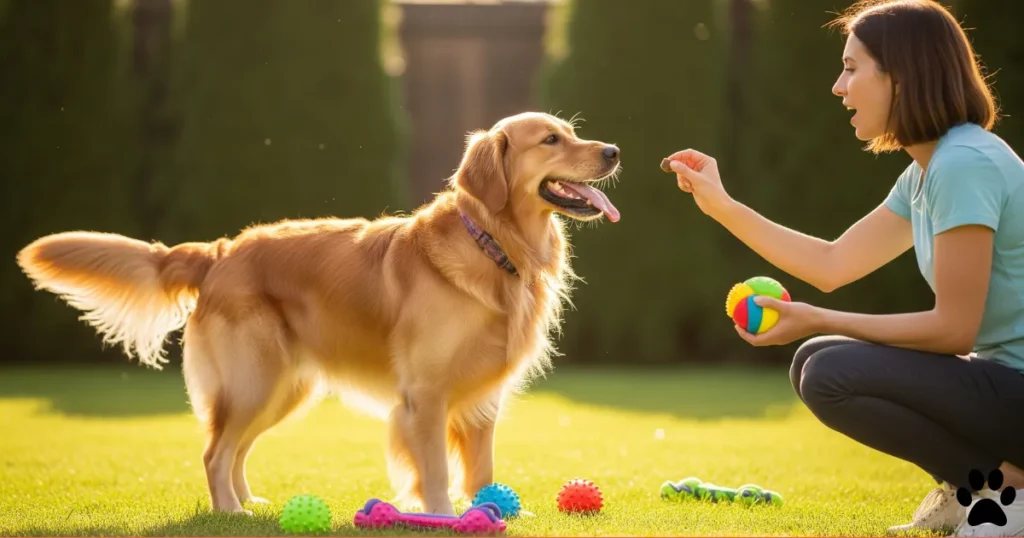
Basics: The First Basic Commands Every Golden Retriever Should Know
To begin training your Golden Retriever, you must first develop a solid understanding of the basic commands. Not only will these introductory lessons teach you important control and communication skills, they will also build your dog’s confidence and lay the foundation for more advanced training in the future. Mastering these five basic commands – sit, stay, come, down, and out – will greatly improve your everyday communication and help you raise a well-behaved, happy pet.
Why are these commands so important
These basic commands are critical to your Golden Retriever’s safety, well-being, and full integration into your life. “Sit” is a polite greeting and the starting point for many other commands. “Stay” teaches self-control and is essential for ensuring safety in many situations. “Come” is perhaps the most important command to ensure that your dog comes when you call him, thereby avoiding potentially dangerous situations. “Down” is a calming and useful position that you can place your dog in a variety of situations. “Leave him alone” can prevent your Golden Retriever from picking up or swallowing potentially dangerous objects.
A Brief Introduction to Learning Each Command
Sit:
Place a treat in front of your dog’s nose and gently move it over his head toward his tail. As his nose follows the treat, his rear end will naturally drop into a sitting position. When his bottom touches the ground, say the command “sit” and reward him immediately.
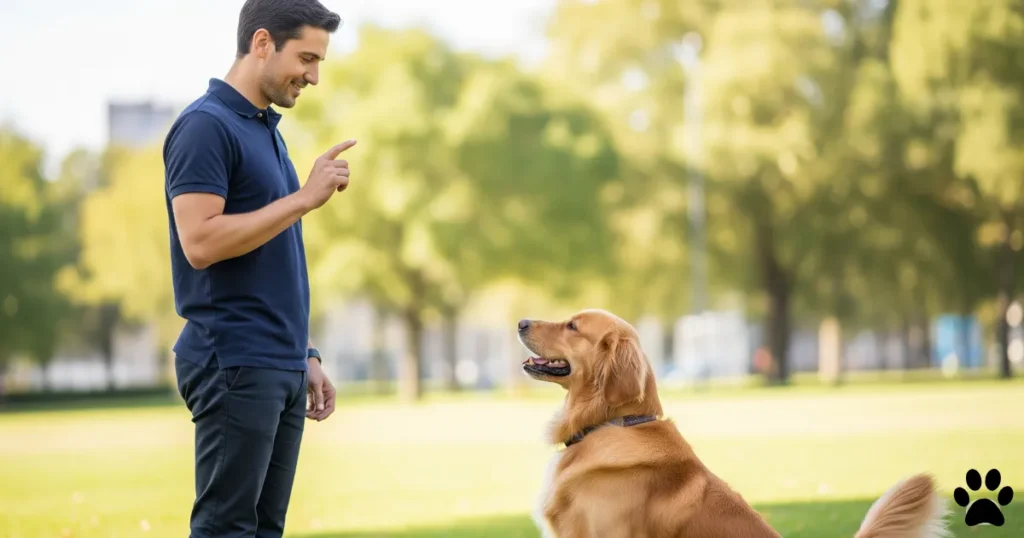
Stand:
When your dog is sitting or lying down, raise your hand, stopping the movement, and say “Stand.” Start with very short periods of time and distance and gradually increase them as your dog understands the command. Reward them for staying in their position.
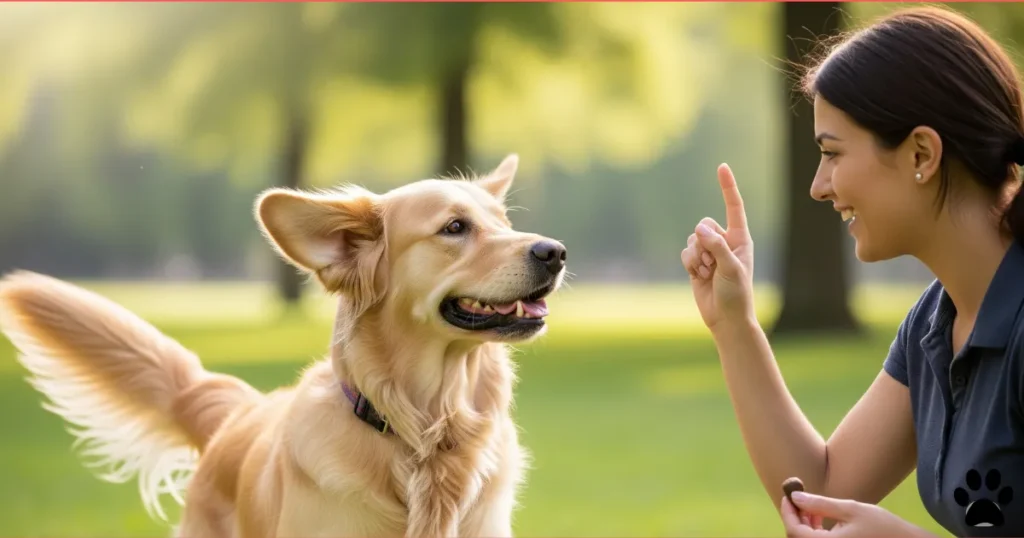
Let’s get started:
Use an excited, cheerful tone. Say your dog’s name, then say, “Come!” Gently tug on the leash if you have one, and enthusiastically reward them with praise and a treat when they come to you.
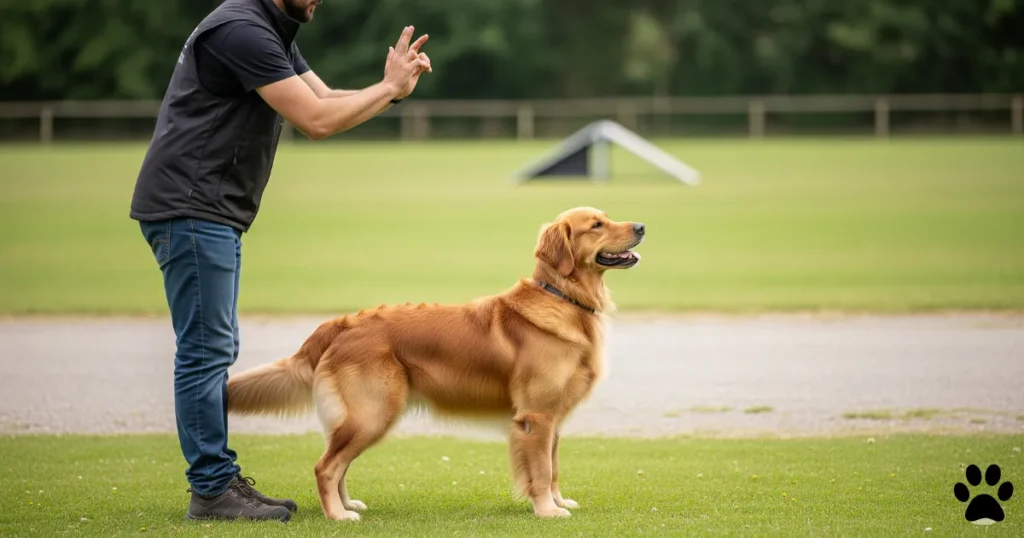
Down:
Similar to the sit command, hold a treat up to their nose and move it down between their paws toward the floor. When the treat is given, they should lie down. When they sit, say sit and reward them.
Leave It:
Place the treat on the floor and cover it with your hand. Say, “Don’t do that.” When your dog stops trying to get the treat, reward them with another, higher-value treat from your other hand. Gradually make it more difficult by showing the treat for short periods of time.

Paws in the Right Place: How to Potty and Crate Train a Golden Retriever
House training and crate training are two key aspects of raising a well-adjusted Golden Retriever. While they require patience and consistency, learning these procedures early on will go a long way toward providing your furry friend with a clean home and a safe, cozy den. Understanding typical schedules and effective techniques will set you and your Golden Retriever on the path to success.
Keep to a Schedule: How Long Does House Training Typically Take?
The length of house training will vary depending on your Golden Retriever’s age, his individual learning pace, and your consistency. Puppies will typically take longer to complete the process than adult dogs. With consistent effort and a clear training program, you can usually make significant progress within a few weeks or months. Accidents are normal, especially in the early stages. So patience is key.
Creating a Routine: Tips for Esta blishing Potty Time
Consistency is the key to successful house training. Establish a regular walking schedule for your Golden Retriever, taking them on frequent walks. Do this first thing in the morning, before bed, after meals, and after play. Reward them immediately with praise and treats when they go outside to relieve themselves. Supervise them in the house and eliminate any signs of intrusion. Then take them out immediately.
Cave Power: Speeding Up Training with Crate Training
Boxing training can be a valuable tool for speeding up house training. Dogs naturally avoid soiling their sleeping area. By presenting the crate as a positive, safe place, you can take advantage of this instinct. Never use the crate as a punishment. Gradually introduce positive associations, such as treats and Toys. A crate that is large enough to allow your Golden Retriever to stand, turn around, and lie down comfortably. A crate can help establish a regular urination and defecation schedule, as dogs eliminate less frequently in the den and learn to hold their bowel movements until they can go outside.
Happy Walks: Learn How to Use a Leash for Calm Walks with Your Golden Retriever
Calm walks with your Golden Retriever are one of the greatest joys of dog ownership. However, these idyllic walks can quickly turn into a tug-of-war if your four-legged friend has not yet learned to walk properly on a leash. Forming good sleep habits from an early age is critical to your safety, your dog’s well-being, and your overall enjoyment of being with him. Teaching your Golden Retriever to walk well on a leash will make your walks a pleasant, stress-free experience.
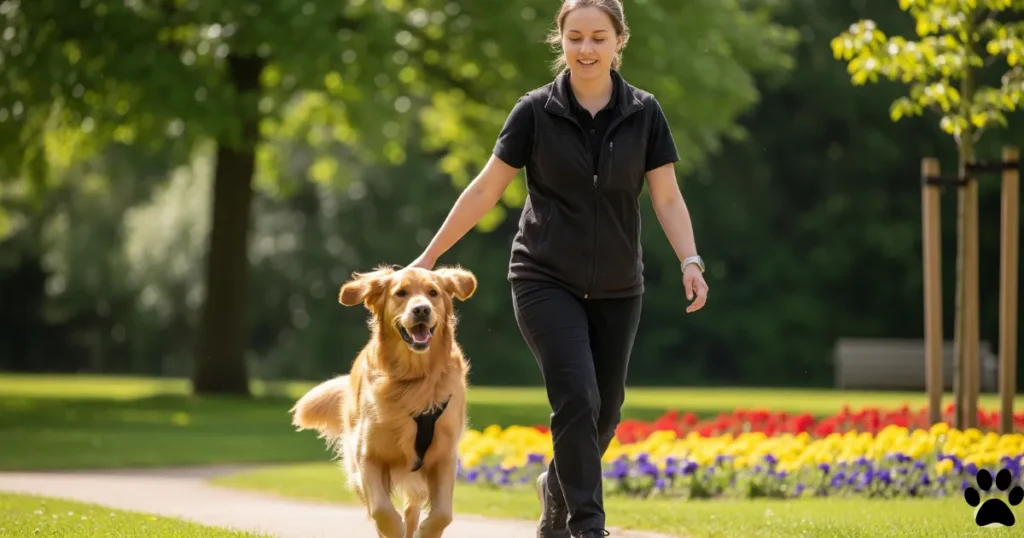
Paving the Way for Success: The Importance of Human Warmth Early on
Ideally, the leash and collar or harness should be introduced to your dog in a positive way when he is still a puppy. Train your Golden Retriever to wear a collar indoors before taking him outside to make the transition easier. Teaching your dog to walk on a leash at an early age will establish a foundation of polite behavior while walking. It will also prevent him from pulling, lunging, or engaging in other unwanted Behavior that can make walks difficult.
Important Line Control Signals: Heel, Stop, and Go
Three basic signals greatly improve your line control:
Heel:
This will teach your Golden Retriever to walk comfortably next to you, maintaining the same pace and position.
Stop:
This command tells your dog to stop when standing still, and prevents him from moving forward.
Walk:
This signal means that your dog should be given more freedom to roam on a leash. They can sniff and explore at a reasonable distance, but the leash should still be loose.
By consistently using these cues in combination with positive reinforcement, your Golden Retriever will learn to understand your expectations while you walk.
Choosing the Right Equipment: Tools for Effective Line Control
Choosing the right equipment can make learning to fish much easier. A comfortable, well-fitting collar or harness is essential. For dogs that tend to pull on the leash, harnesses with front clips or halters can provide more control. However, they should be introduced gradually and with positive reinforcement. A standard leash of 4 to 6 feet in length is generally recommended for training. Avoid using retractable leashes when first training, as they can make communication and control more difficult.
Change Your Approach: Puppy and Adult Dog Training Methods for Golden Retrievers
While the basic principles of dog training remain the same, the specific methods you use may need to be adjusted depending on whether you are working with an active puppy or a calmer adult Golden Retriever. Understanding the key differences in your youngsters’ learning styles, energy levels, and motivations will help you tailor your approach for optimal success at each stage of their life.
Navigational Differences: Approach, Attention Span, and Energy Levels
Puppies often have shorter attention spans and boundless energy. To maintain their focus, training sessions should be short, frequent, and highly engaging. Their training is often based on exploration and immediate reward. Even though adult dogs have longer attention spans, they may still have pre-existing habits, both good and bad. Their energy levels may fluctuate, and they may need more patience to unlearn old habits.
Understanding Motivation: What Drives Training at Each Age
Puppies tend to be highly motivated by treats and play. They also develop a desire to please, which makes positive reinforcement especially effective. Adult dogs can also be motivated by treats and toys, but they may also be motivated by a desire for routine, security, and a stronger bond with you. To fully realize your Golden Retriever’s learning potential, you need to understand what excites him most at this stage of his life.
Adjusting Your Expectations: Patience and Progress
It’s important to adjust your expectations according to the age of your Golden Retriever. With puppies, you need to focus on building a strong foundation and rewarding even small successes. Progress may seem quick at first, but as you move through adolescence, consistency is key. Be patient and persistent with older dogs. Changing established behavior may take time and repetition. Celebrate small successes and remember that building trust and a positive relationship is key, no matter what age.
Troubleshooting Training: Overcoming Common Problems with Your Golden Retriever
Even the most enthusiastic Golden Retriever may encounter some obstacles during training. Stubbornness may set in, motivation may wane, and progress may sometimes seem slow. Understanding these common problems and knowing how to solve them is critical to staying on track and ultimately achieving your training goals. Remember, you are not alone, and there are effective strategies for overcoming these obstacles.
Overcoming Stubbornness: Overcoming Stubborn Behavior
What appears to be stubbornness in your Golden Retriever may actually be a result of misunderstanding, confusion, or a lack of motivation. If your dog resists, repeat the basic steps. Make sure your commands are clear and consistent, your rewards are valuable, and the training environment is free of distractions. Even short, focused sessions can be helpful. Sometimes a small adjustment in approach or breaking the task down into smaller steps can make all the difference. For more detailed tips, see our article: [Link to: How to Handle a Stubborn Golden Retriever].
Keep the Spark: Stay Motivated Even When You Fail
Training isn’t always a linear process. There will be days when progress seems slow or even stalled. During these times, it’s important to stay motivated. Celebrate small successes, remind yourself of the progress you’ve already made, and don’t be afraid to take short breaks when you’re feeling frustrated. Be sure to vary your training sessions to keep them interesting for both you and your Golden Retriever. Remember why you started training: to strengthen your bond with your dog and make him an obedient companion. Understanding common mistakes can also help you stay on track. Our guide [link to: “Common Training Mistakes to Avoid”] provides valuable information.
Know When to Call in the Experts: Seek Professional Help
While many training challenges can be overcome with patience and consistency, there are times when it’s best to seek professional advice. If you’re struggling with persistent behavior issues, aggression, or extreme anxiety, or are feeling overwhelmed by the training process, a certified professional dog trainer or animal behaviorist can provide valuable support and tailored strategies. They have the experience to assess the situation, identify root causes, and develop a customized training plan that will meet your specific needs and the unique challenges of your Golden Retriever. Don’t be shy about seeking professional help; it can make a significant, positive difference to your relationship with your dog.
Set Up for Success: Training Tools to Help Your Golden Retriever Learn
Patience and consistency are the cornerstones of effective Golden Retriever training. But with the right Tools, you can greatly improve the training process and make communication clearer. There are many training materials available, each serving a specific purpose: to help your furry friend become an obedient companion. Understanding how to use these tools effectively will make your training more effective and enjoyable.
Important Training Aids and Their Purpose
Clickers:
These small devices make a specific sound that can be used as a dialing signal. They indicate the exact moment when your Golden Retriever exhibits the desired behavior, followed by a reward.
Treats:
Having high-quality treats on hand allows you to quickly and timely reward your dog during training.
Leash:
A standard leash of 4 to 6 feet (1.2 to 1.8 meters) provides control and direction during walks and training.
Harnesses:
Harnesses with a handle at the front or back can make leash walking more comfortable and controlled, especially for dogs that tend to pull.
Training Mats:
These designated areas will help your Golden Retriever focus during training and learn to stay in one place.

Choose the Right Equipment for Your Golden Retriever
Choosing the right type of training equipment depends on your Golden Retriever’s size, age, temperament, and specific training goals. Make sure collars and harnesses are comfortable and secure, but not too tight or too loose. Introduce new tools gradually and with positive associations.
Make Time for Exercise: Create a Regular Routine for Your Golden Retriever
In the hustle and bustle of everyday life, finding time to train your Golden Retriever can seem like just another task on a long to-do list. However, the key to effective dog training is consistency. By carefully planning your time and incorporating short, regular training sessions into your daily routine, you will make significant progress and strengthen your bond with your furry friend. Quality is key, not quantity, and make exercise a natural part of your day.
Create a Realistic Daily Training Plan
Start by assessing your daily routine and identifying small blocks of time where you can fit in 5-10 minutes of exercise. This could be before breakfast, after a walk, during a commercial break on TV, or before bed. Aim for consistency rather than long sessions. Even a few short, focused workouts a day produce better results than long, infrequent sessions.
Finding the Right Frequency: How Often Should You Train?
A minimum of two to three short workouts a day is ideal. Puppies with shorter attention spans may benefit from even more frequent, short interactions. Monitor your Golden Retriever’s energy level and adjust accordingly. The key is to make exercise a regular habit, just like eating or walking.
The Importance of Balance: Movement, Play, and Rest
While consistent training is important, it’s equally important to balance it with play and adequate rest. Training sessions should be positive and exciting, stimulating your Golden Retriever’s mind without overwhelming him. Play time provides an opportunity to reinforce commands in a fun and interactive way, while adequate rest is essential for learning and overall well-being. A balanced daily routine with exercise, play and rest will help to produce a happy and well-adjusted Golden Retriever.
Golden Path to the Future: Latest Tips and Suggestions for Your Training Journey
As you embark on the exciting adventure of training your Golden Retriever, remember that every step you take, no matter how small, is a positive step toward raising a well-behaved, happy friend. Celebrate small successes—the first successful sit, a walk on a slightly loose leash, a moment of calm during the stay command. These accomplishments are a testament to your dedication and growing understanding of your Golden Retriever.
It’s also important to understand that every dog is an individual. Don’t compare your Golden Retriever’s progress to that of other Golden Retrievers you know. Adapt to your individual training style and pace. Training isn’t just about giving commands. It’s a great opportunity to strengthen your bond, build trust, and learn how to communicate effectively with your furry family member. Approach each session with patience, positivity, and love, and you will be amazed at the incredible bond you will build. For more advice and insight into specific training areas, check out our support blog posts. They will provide valuable insight into your journey. Enjoy the process and appreciate the wonderful relationship you are building with your Golden Retriever!
Conclusion:
This Golden Retriever Training Guide takes you on a comprehensive journey, from introducing new owners to the world of Golden Retrievers to emphasizing the importance of early training. You’ll learn how to analyze Golden Retriever behavior, when is the best time to begin training, and the basic principles that apply to successful training. We discuss the most important commands, house and crate training, and how to train your dog to walk calmly on a leash. The guide also discusses the intricacies of puppy and adult dog training methods, how to overcome common problems, and what tools you can use to support you. Finally, we discuss the importance of time management for consistent training and offer a few final words of encouragement. By following this guide, you’ll be well prepared to build a strong, positive relationship with your Golden Retriever through effective and consistent training.
Dr. Nabeel A.
Hi, I’m Dr. Nabeel Akram – a farm management professional by trade and a passionate Golden Retriever enthusiast at heart. With years of experience in animal science and livestock care, I’ve built a career around understanding animals—how they live, thrive, and bring value to our lives. This blog is a personal project born from that same passion, focusing on one of the most loyal and lovable breeds out there: the Golden Retriever. Whether I’m managing farm operations or sharing insights on canine health, behavior, and care, it all ties back to one core belief—animals deserve thoughtful, informed, and compassionate attention. Welcome to a space where professional expertise meets genuine love for dogs.
Facebook |
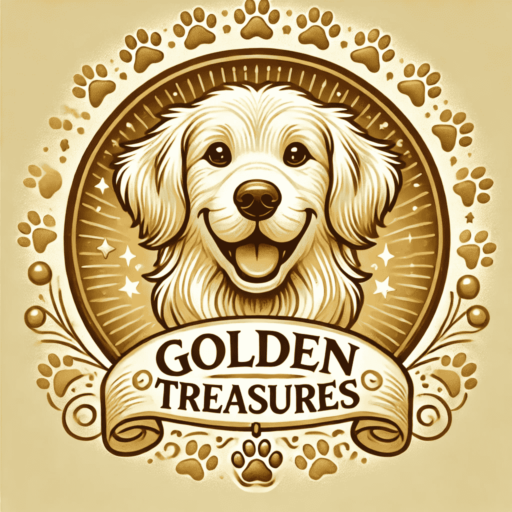
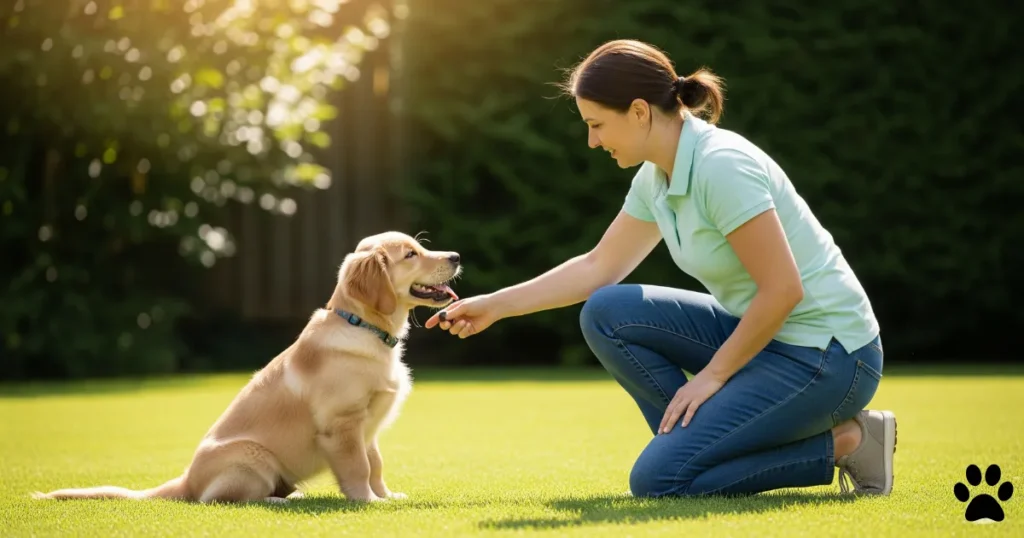
Links will be automatically removed from comments.